Missionary Injured in Terrorist Bombing Attends U.S. Naval Academy, Continues to Share the Gospel
Contributed By Jason Swensen, Church News associate editor
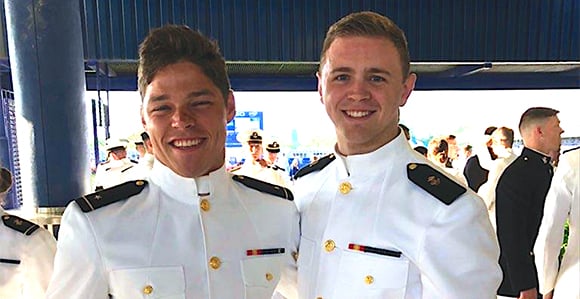
Mason Wells, right, and fellow returned missionary, Christian Martin, smile at the 2018 graduation exercises at the United States Naval Academy. Wells was injured in the 2016 Brussels airport attack while serving in the France Paris Mission.
“I found myself talking about my mission at least once a week at the Academy. … Because of what I went through—and because I’m still a member of the Church—I have gained a certain respect for my religious views.” —Mason Wells, returned missionary injured in the Brussels airport attack
Related Links
A popular adage at the United States Naval Academy aptly describes the unusual student life at the 173-year-old military school: Not College.
Besides carrying a STEM-centric class load (physics, calculus, and chemistry), every USNA midshipman must master seamanship fundamentals, sweat out endless numbers of push-ups and pull-ups, and keep his or her dorm room in, well, shipshape.
So adjusting to academy life is challenging for even the most dedicated student. It’s supposed to be tough.
But Mason Wells is a tough young man.
Long before enduring the rigors of military life at the academy, Mason survived almost unimaginable pain and horror.
Latter-day Saints know his story well.
He was one of four full-time missionaries injured in the March 22, 2016, Brussels airport terrorist attack. The young elder suffered serious injuries in the explosion, spent months in the hospital, and endured multiple surgeries and medical procedures.
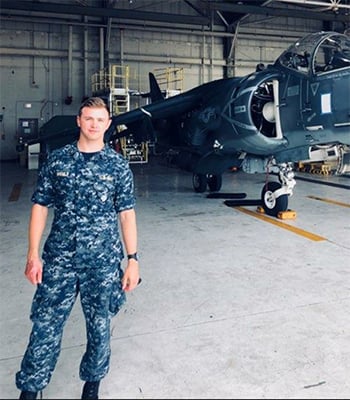
United States Military Academy Midshipman Mason Wells plans to become a military aviator following graduation. Photo courtesy of Mason Wells.
“I still have shrapnel in my head and in my legs—there are some things that are just going to stay with me,” he said matter-of-factly.
But he marked a key moment in his recovery in the summer of 2017 when he reported for Induction Day at the Naval Academy, fulfilling a promise he made himself years earlier. Many of his relatives had served in the military, and he was determined to also wear his country’s uniform.
Wells was warned his freshman year (or plebe year in academy-speak) would be long and sometimes lonesome. First-year students enjoy few privileges and plenty of new rules and regulations. Even walking in the dorm hallways is prohibited—plebes must “chop” or jog through the massive Bancroft Hall.
“And to be honest, it was really challenging. … We’re placed under a lot of stress. Plebe year was about breaking away from the civilian mold and living a military lifestyle,” he said.
But while most of his new classmates were weeks removed from high school graduation, Wells arrived at the academy seasoned by mission moments both joyful and tragic.
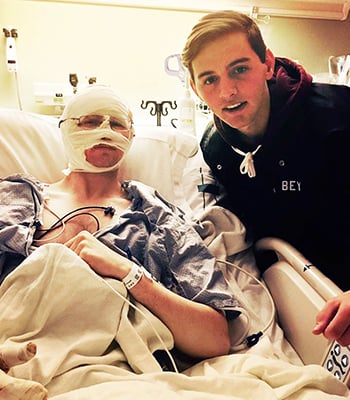
Mason Wells, left, one of four missionaries wounded in the Brussels airport attack, poses for a picture with his brother, Colby, in the burn unit at University Hospital in Salt Lake City on March 29, 2016. Photo courtesy of the Wells family.
Serving in the France Paris Mission, he said, “gave me the confidence and understanding that I can do anything with the Lord’s help.”
Reid and Shirley Chambers immediately spotted Wells’s quiet self-assurance. The Chambers were serving as military missionaries in Annapolis when he arrived for Plebe Summer. Each Sunday, Elder and Sister Chambers visited the academy to join the Latter-day Saint plebes for a brief sacrament service. Despite the rigors of basic training, Wells was always on the lookout for others needing an encouraging word or a welcoming handshake.
“Mason made others feel like they were his best friend,” said Reid Chambers.
Most of Wells’s classmates knew nothing about his connection to the Belgium terrorist bombing until the 2017 release of the hope-driven book he coauthored entitled Left Standing.
“Word spread pretty quickly. … I definitely felt more scrutinized. It was always on the radar.”
Most at the academy were supportive. Some were not. But the awareness of his past prompted frequent discussions.
“I found myself talking about my mission at least once a week at the academy,” he said. “Because of what I went through—and because I’m still a member of the Church—I have gained a certain respect for my religious views.”
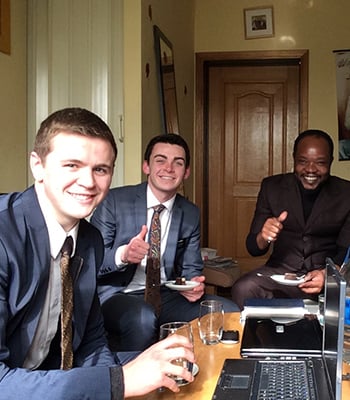
Elder Mason Wells, left, and Elder Joseph Dresden Empey, center, serving in Brussels, part of the France Paris Mission. They had been companions for a month before they were injured in a terrorist attack on the Brussels airport on March 22, 2016. Photo courtesy of the Empey family.
Like the shrapnel in his body, the memories of the airport bombing remain. A grueling week of academic exams during his first plebe semester triggered unwelcome emotions.
“At the end of the week, I had a pretty traumatic memory from the airport,” he said. “I remember breaking down in my room because I was experiencing some of the same things I had experienced in the airport. I had many stresses going on in my life.”
But help arrived unexpectedly.
“At that very moment, my company commander walked in my room and talked with me. Our talk, along with a lot of the prayers I had sent up, reminded me of an eternal perspective that life is bigger than the stresses of the day and the problems of tomorrow.”
“I remembered that we have so much more to live for.”
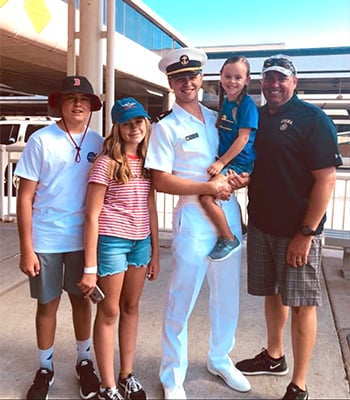
United States Naval Academy Midshipman Mason Wells stands with members of his family. Mason survived the 2016 airport terrorist attack in Belgium while serving as a missionary. Photo courtesy of Mason Wells.
Midshipman Third Class Wells no longer wears a missionary name tag. But he still seeks opportunities to share the gospel. In a few days, he is baptizing a fellow midshipman.
“We met through mutual friends. She started taking the missionary discussions, and I’ve been there every step of the way.”
Wells is majoring in aerospace engineering and plans to become a U.S. Marine Corps aviator following graduation. He’s learned military life is far different from missionary life. But in proven missionary-form, he relies upon prayer and testimony to overcome life’s inevitable challenges.
“I had to adapt and recognize that I’m not surrounded by Church members [at the academy],” he said. “I didn’t have time set aside here for spiritual aspects like I did on my mission, so I needed to make that a priority.”
Fellow Latter-day Saints agree Wells is well equipped for the days and years ahead. He still stands tall.
“Mason is just a great guy,” said Reid Chambers, “and a great example to all of us.”
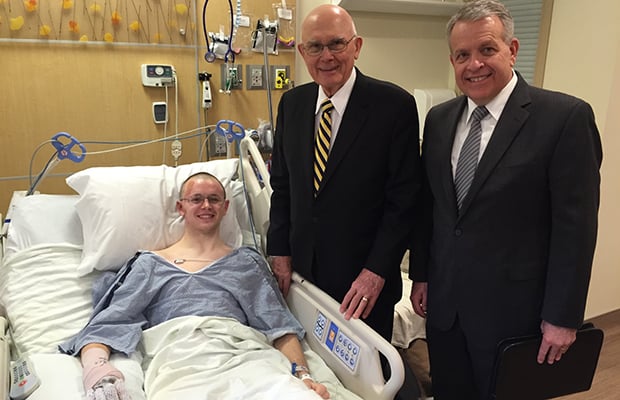
Mason Wells, left, one of four missionaries wounded March 22, 2016, in the Brussels airport terrorist attack, smiles during a visit with Elder Dallin H. Oaks of the Quorum of the Twelve Apostles and Elder Brent H. Nielson, Executive Director of the Missionary Department of The Church of Jesus Christ of Latter-day Saints, at the University of Utah burn center on March 30, 2016. Photo courtesy of the Wells family.
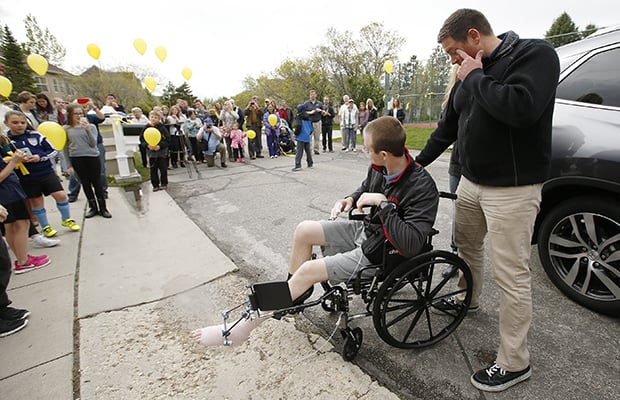
Elder Mason Wells is pushed by his father, Chad, as he returns home and is welcomed by friends and family in Sandy on April 28, 2016, after spending 37 days in the hospital due to injuries from the Brussels terrorist attack. Photo by Jeffrey D. Allred, Deseret News.
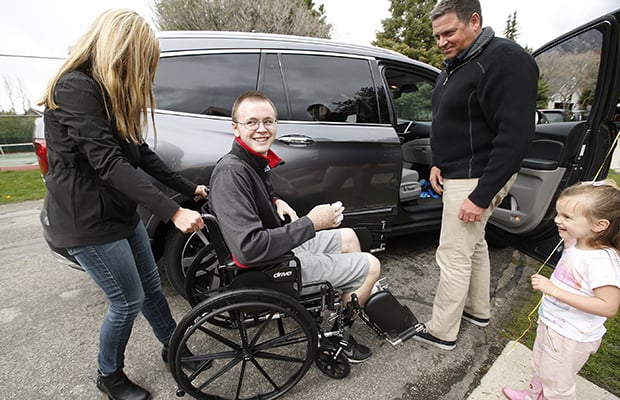
Elder Mason Wells returns home with his parents, Chad and Kym, in Sandy on April 28, 2016, after being injured in the Brussels terrorist attack while serving in the France Paris Mission. Photo by Jeffrey D. Allred, Deseret News.
